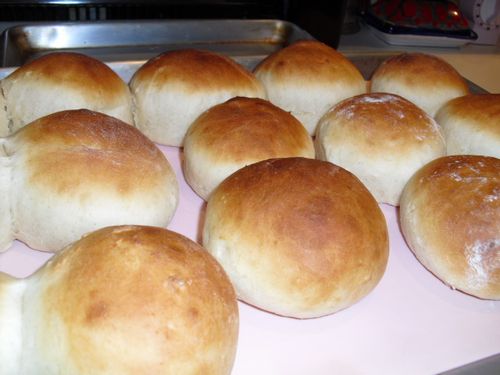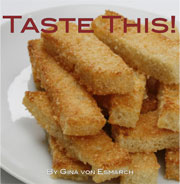Bread, Glorious Bread

Today, I'd like to introduce you to Gina from Bowl Licker. She's a dear twitter pal and I'm eagerly awaiting our IRL meeting at Blogher Food in her hometown of San Francisco at the end of September (that happens to be my second fave city next to NYC). Gina's talking bread today. I can relate to her addiction, as right now I'm snacking on some with a smear of homemade tomato jam. See those buns above? Those are Gina's. Well, I mean they're her sweet hot Norwegian buns. I'd like to pile some pulled pork and homemade coleslaw on them (ok, this is getting weird even for me). Thanks again Gina for guest blogging. Hope we see you here again real soon.
-Jennifer
***
For the Love of Bread
I'm not here to merely talk about my carb addiction to bread (yes, glorious bread) but more about digging down to the very crust of it all. Because it is for me, at the very root of the bread-addiction, to be blamed almost entirely upon my family and my heritage. Growing up with a strong, if not occasionally overpowering, Italian heritage is clearly seen in the foods I crave.
While my father’s side cooked predominately with a Northern Italian flare it was my mother’s side that cooked Sicilian (or Southern Italian) food. It is truly difficult to say that one region’s cooking is better than the other, as there is such a variety of food combinations once you move beyond the stereotypes of the ever delectable pasta and pizza. So eating what my mother prepared from her built in index of home cooking enabled me to eat a lot of Sicilian foods. She also cooked a number of other worldly wonderful dishes but this is about my recollection of those fantastic Sicilian dishes as recently recaptured on our Food-cation this past week.
The basic ingredients to 80% of the recipes are: breadcrumbs, garlic, oregano, basil and olive oil. Spending the week with my mom at her vacation home is always a food extravaganza – so worrying about squeezing into my bathing suit during the afternoon would be a wasted empty effort. No matter how huge I may feel, I am told that I always have room for dinner AND desert…oh, and wine since it technically = water, or so it did in the New Testament, so it shall at our table too.
The menus read like some fine dining restaurants, and well, since we are a restaurant family that should hardly be a surprise to me, and yet I am forever surprised at how effortlessly she cooks these incredibly divine meals. It is a treat in itself to think of how many things we eat that are breaded in diverse mixtures with similar core ingredients. For example, on the first night my mother breaded swordfish and baked it in the oven until the coating was crisp and the fish perfectly flaky. On the second night we prepared meatballs, which not only had bread incorporated into the meat mixture but were then breaded, fried and then slow cooked in her homemade “sugu” (or meat sauce). The third night, we had breaded prawns and NY steaks. She broke with her typical breaded surf and breaded turf tradition and agreed to cook the steaks on the BBQ along with the potato wedges that were cooked in olive oil and onions.
In my family, despite how outrageous it seems to cover up a fantastic cut of meat or dozens of delicate prawns with breadcrumbs my mother has a way of preparing food that comes out light with but a hint of oil. The familial term for the delectable crunch of salty, slightly chewy breadcrumbs comingled with olive oil is “mudiga” – aka the sauce at the bottom of the pan that we all fought over with spoon in hand.
For each breaded dish the seasonings are similar and yet the balance is changed much like the six different tomato sauces we make for various dishes – one for the fried eggplant, one for the quick pasta sauce – recipe found in my book Taste This– one for the pasta with eggs, one for the chiopino, and well you get the idea. The devil is in the details and while we’ve managed to convert most of the recipes that read two handfuls of X into exact measurements, these details are key to the balance of each dish being distinctly different from the next.
While I do not typically cook these dishes at home, I never pass up an opportunity to eat them and for special gatherings my friends continue to ask me if when I come over if I could make one of my mother’s dishes because they are truly wonderful and ridden with all those things we think we shouldn’t indulge in – that said, life is too short and cooking at home allows you the opportunity to take risks and make memorable food choices. I’ve never regretted going old school on the cooking front and while I don’t often talk about my culinary upbringing it’s only because I know it is to be coveted. I encourage you to take a risk, to indulge and to go old school – and I look forward to hearing about your favorite ingredients or family recipes.
It is amazing as a standalone item for nearly any meal of the day and it can be transformed to accent most every meal…did I mention that one of my grandmother’s favorite desserts was to eat sliced white bread with a wedge of watermelon? You have really no idea how many ways we managed to incorporate bread, even when it was not necessary. Then again many luxuries are not really necessary, but some are quite tasty.
BREADED SICILIAN FISH
Serves 4
1 cup breadcrumbs, unseasoned
1 teaspoon Italian Seasoning
1/4 cup Italian flat leaf parsley, fresh chopped
1 teaspoon garlic salt
salt & pepper to taste
olive oil
4 boneless fillets, fresh fish (I like to use swordfish, petrale sole, rock fish or tuna but this does not work on salmon or other thick cut fish)
4-6 lemon wedges (optional)
Rinse fish and pat dry. In a medium size, wide bowl mix breadcrumbs, Italian Seasoning, parsley, garlic salt, salt and pepper. Coat fish lightly with olive oil, then dip in breadcrumb mixture. Preheat oven to 350 degrees and place prepared fish on foil lined cookie sheet to minimize clean-up. Cook for 3 ½ minutes and flip fish once. Cook for no more than 7 minutes total – this will depend on the type of fish. Mangia bene!

Buy Gina's book at www.bowllicker.com, and learn how to bring great flavors to the table in no time.
Gina von Esmarch was born and raised in the San Francisco Bay Area. She is a fourth generation San Franciscan, who’s family
has successfully run one of the City’s oldest fine dining restaurants at Fisherman’s Wharf — Alioto’s #8, founded in 1925. Gina now lives North of the Golden Gate Bridge with her husband, children and dog. In her free time she enjoys spending time around the table with her family and friends.

Jen @ My Kitchen Addiction
Sounds absolutely delicious! Great guest post.
Gina von
Thank you so much for the opportunity to guest blog for you- it is an honor!
Wis Dell’s Fried MAC & Cheese Bites « Bowl Licker
[…] ½ cup Italian seasoned breadcrumbs […]